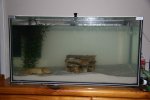need some help. I'll give some history first
My son and i are new to Axolotl's. we set up the tank 5 mts ago and let it cycle for 4 weeks before putting Fluffy into the tank. to start with under the advise from the pet shop we brought him from we had gravel in the bottom but have now changed it to sand. as we have now learnt the pet shop has given us a lot of bad advise. we have also fitted a spray bar to the fillter. we do a 15% water change every 2nd day (can't seem to keep water quality any other way). do our best to maintain water temp tank is in coolest room away from sun light and use ice bottles on hot days but it has risen to mid to high 20s a couple of times. some very hot days here in Perth.
Fluffy stop eating 5 weeks ago after a very hot spell. Prior to this he would eat 1/2 a cube of beef heart every 2nd day with out fuss. He was also very active at night. once he stoped he became very inactive. we tried different foods after reading on this forum to vary his deit. we have tried earthworms, brood worms and axie peletts he show intrest in the earthworms and ate one but latter brought it back up. After about 2 weeks of not eating we put him in the fridge as per the info on this site. he seemed to perk up but still did not eat. after 2 week in the fridge i found a vet here in perth that would look at him. She wasn't sure what was wrong but gave him a ultra sound to make sure that he hadn't swollowed some gravel (it was all clear) and gave him a injection of Baytril and has got us to give him orally a drop of Metacam and 0.01ml of Baytril for 4 days today been the last day. she also surgested that we put him back in his tank which i did yesterday. He is still not eating and now he is floating at the top of the tank a lot and is very inactive again.
i have also included some photos of Fluffy and his tank.
Any suggestions will be great as I am worried we may lose him if he dosn't eat soon and my son will be very upset as he has become very attached to Fluffy and it took him 12mts of saving his pocket money to buy every thing.
Thanks
Rob and Brendan
My son and i are new to Axolotl's. we set up the tank 5 mts ago and let it cycle for 4 weeks before putting Fluffy into the tank. to start with under the advise from the pet shop we brought him from we had gravel in the bottom but have now changed it to sand. as we have now learnt the pet shop has given us a lot of bad advise. we have also fitted a spray bar to the fillter. we do a 15% water change every 2nd day (can't seem to keep water quality any other way). do our best to maintain water temp tank is in coolest room away from sun light and use ice bottles on hot days but it has risen to mid to high 20s a couple of times. some very hot days here in Perth.
Fluffy stop eating 5 weeks ago after a very hot spell. Prior to this he would eat 1/2 a cube of beef heart every 2nd day with out fuss. He was also very active at night. once he stoped he became very inactive. we tried different foods after reading on this forum to vary his deit. we have tried earthworms, brood worms and axie peletts he show intrest in the earthworms and ate one but latter brought it back up. After about 2 weeks of not eating we put him in the fridge as per the info on this site. he seemed to perk up but still did not eat. after 2 week in the fridge i found a vet here in perth that would look at him. She wasn't sure what was wrong but gave him a ultra sound to make sure that he hadn't swollowed some gravel (it was all clear) and gave him a injection of Baytril and has got us to give him orally a drop of Metacam and 0.01ml of Baytril for 4 days today been the last day. she also surgested that we put him back in his tank which i did yesterday. He is still not eating and now he is floating at the top of the tank a lot and is very inactive again.
i have also included some photos of Fluffy and his tank.
Any suggestions will be great as I am worried we may lose him if he dosn't eat soon and my son will be very upset as he has become very attached to Fluffy and it took him 12mts of saving his pocket money to buy every thing.
Thanks
Rob and Brendan



